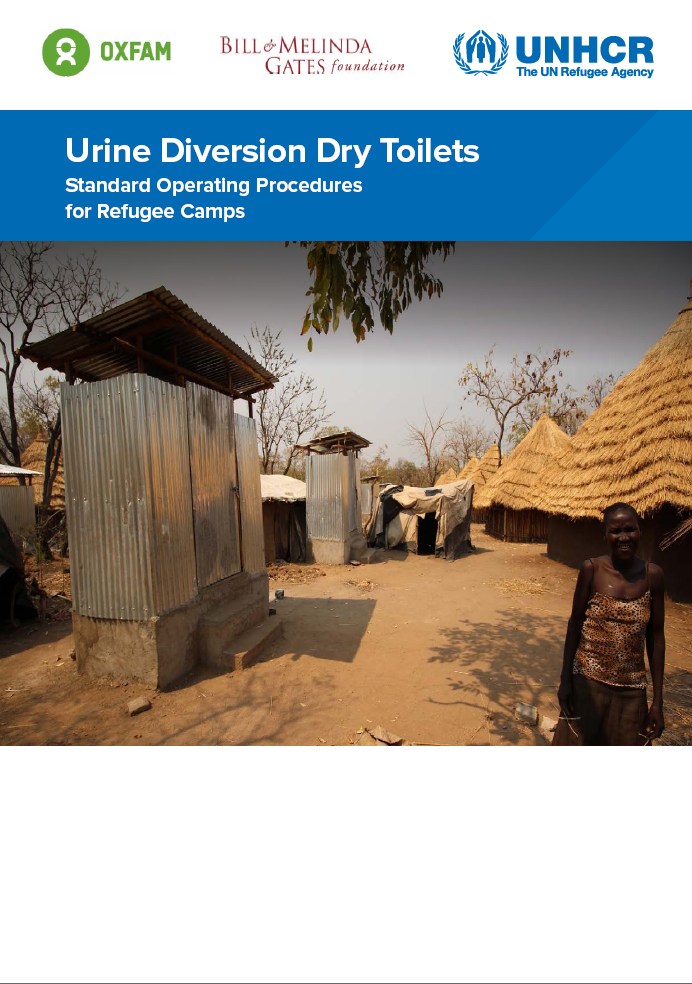
Double vault Urine Diversion Dry Toilets (UDDT) can be used as an alternative to pit latrines in refugee camps. They utilise two chambers for faeces, one of which is in use whilst the other is full and drying so that it can be safely disposed of after an appropriate period of time.
These Standard Operating Procedures (SOPs) were developed by Oxfam under UNHCR’s “Waste to Value” Project, which was funded by the Bill and Melinda Gates Foundation. They are largely based on UDDTs developed under the Waste to Value Project in Ethiopia.

Where required, UNHCR and WASH actors should work together to develop a country level refugee WASH strategy document that clearly describes the refugee context and the baseline WASH situation, along with short, medium and long-term strategies for each of the WASH sub-sectors. This template can be used to help produce a short and concise Country level WASH Strategy. It includes a phased approach, HR requirements and site-level Operational Plans.

These guidelines provide additional support and information on designing and implementing hygiene promotion programmes or elements of hygiene promotion in the programmes of other sectors. They should be used in conjunction with the UNHCR WASH Manual and the summary guidance in the Hygiene Promotion Chapter of this manual.

Publisher: UNHCR Year: 2017 Description: UNHCR has developed a standard excel-based form that should be used to capture all the important information during well construction. The excel file can be downloaded by following the link at the bottom of this page. Once you have downloaded the excel file, you can watch the explanatory videos. Three […]

The UNHCR WASH Manual: Programme Guidance, provides practical guidance for WASH programmes in refugee settings.

This report is based on a desk-based review of secondary data, comprising published material as well as grey literature, supplemented with key informant interviews for programmes that lacked documentation. Section One summarises the current use of CBI in WASH programming. Section Two summarises the best practices and lessons learned including challenges faced, drawing on evidence from the project examples found. Section Three provides recommendations and best practice guidance for use of CBI in refugee settings. Section Four details existing tools and guidance.

A sample organigram for running a typical refugee WASH programme for 20,000 people in a post emergency camp based setting. The organigram gives an indication of how the WASH Team should be structured in addition to the tentative number of Coordinators, Team Leaders, Officer, and Assistant level staff that should be recruited.

This document describes UNHCR’s global strategy for public health through a set of guiding principles and strategic approaches including protection; age, gender and diversity; equity; access; sustainability; community empowerment; appropriateness and reliability; partnerships and coordination; capacity building; communication and advocacy; integrated approaches; measurement and monitoring; and innovation. The document describes strategic objectives and enabling actions per sub-sector (Public Health, HIV and Reproductive Health, Food Security and Nutrition, and WASH).
Tags: Capacity Building, Capacity Building, Capacity Building, Disease Vector Control, Gender, Gender, Gender Based Violence, Gender Based Violence, Human Right to Water / Sanitation, Human Right to Water / Sanitation, Protection, Protection, Public Health, Value for Money, Value for Money, WASH Coordination, and WASH Coordination.

This technical brief is intended to provide guidance for UNHCR staff and Partners involved in winterization of WASH facilities in the current European refugee and migrant situation.
Tags: Cold Climates, Cold Climates, Excreta Management, Excreta Management, Excreta Management, Hygiene Promotion, Hygiene Promotion, Hygiene Promotion, and Piped Water Networks. Locations: Central Europe and the Baltic States, Eastern Europe, and Europe. Categories: WASH Emergency Guidelines, WASH Emergency Tools, WASH Guidelines, WASH Guidelines, WASH Guidelines, WASH Guidelines, and WASH Guidelines.
 English
English










